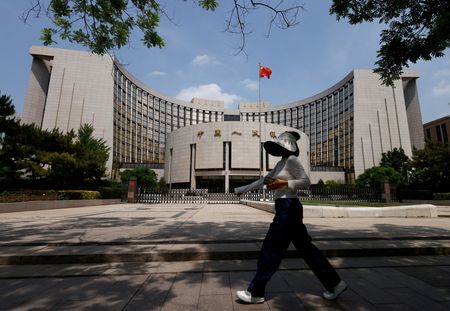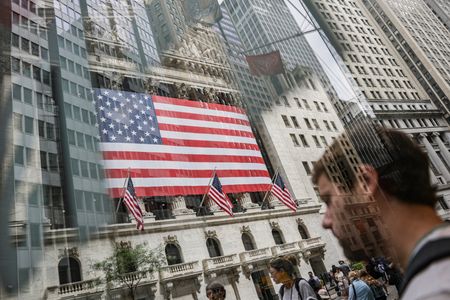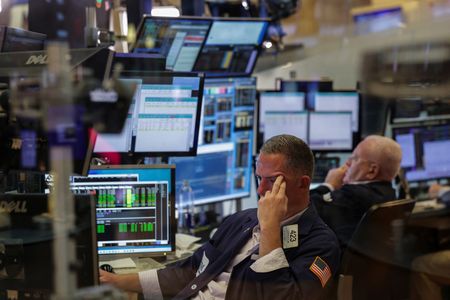By Jamie McGeever
ORLANDO, Florida (Reuters) -TRADING DAY
Making sense of the forces driving global markets
By Jamie McGeever, Markets Columnist
Wall Street took a breather on Thursday, but not before another tech whoosh lifted the S&P 500 and Nasdaq to new highs, while the dollar and bond yields ended little changed as investors trimmed positions ahead of Friday’s U.S. jobs data.
More on all that below. In my column today I analyze Fed Chair Jerome Powell’s press conference, and the message that came across loud and clear – as long as the unemployment rate stays low, it will be very hard to justify rate cuts.
If you have more time to read, here are a few articles I recommend to help you make sense of what happened in markets today.
1. Fed’s reticence on rate cuts forces market to rethinkoutlook 2. BOJ turns less gloomy on economy, keeps rate-hike chancealive 3. U.S.-China trade war could push ECB to continue easing:Mike Dolan 4. Microsoft races past $4 trillion valuation after solidresults 5. Big Tech may be breaking the bank for AI, but investorslove it
Today’s Key Market Moves
* FX: Dollar gains for sixth day, up 2.5% this week. Hitsfour-month high vs yen above 150.00 yen. * STOCKS: S&P 500 and Nasdaq hit new highs but end down0.4% and flat, respectively. Dow falls 0.7%, Russell 2000 loses0.9%. * SHARES/SECTORS: Microsoft shares +5%, Meta +11%, techsector +2%. Apple +3% and Amazon -4% in after-hours tradefollowing earnings. * BONDS: Treasury yields end little changed, after beinglower for much of the day by as much as 5 bps. * COMMODITIES: Comex copper crashes 22% after Trumpexempts refined copper from 50% tariffs. Premium over LMEcopper, around $3,000 earlier this month, virtually disappears.
What stops the tech juggernaut?
It’s easy to forget in the midst of the bullish frenzy, but asset price booms do end, either over time, or more suddenly and painfully. Predicting the catalyst can be difficult, getting the timing right is akin to a lottery.
Right now, the rally in U.S. Big Tech looks unstoppable. Inflation, a hawkish Fed, rising bond yields, tariffs, AI overspend worries? They’ve all been thrown at the sector but it has powered ahead, lifting the S&P 500 and Nasdaq to record high after record high in recent weeks.
Meta and Microsoft did the heavy lifting on Thursday, with Microsoft joining Nvidia in the rarified air of the $4 trillion market cap club. Both Meta and Microsoft’s after-hours earnings reports on Wednesday show their AI bets are paying off.
The global equity picture was much gloomier, however, as Powell’s hawkish signals on Wednesday and U.S. inflation data on Thursday pushed most major indices into the red.
On the macro front, annual U.S. core PCE inflation was 2.8% and the Dallas Fed’s trimmed mean PCE rate shot up to 3.4%, the highest since February last year.
There are signs the tariff effect on goods prices is kicking in. Ernie Tedeschi at the Budget Lab at Yale posted on X that PCE durable goods prices are up 1.7% this year. Excluding the pandemic, that’s the biggest six-month rise since 1987.
On tariffs, U.S. President Donald Trump on Thursday gave Mexico a 90-day reprieve to negotiate a broader trade deal, but is later expected to slap new levies on countries that have not struck trade deals by his 12:01 a.m. EDT (0401 GMT) deadline.
As economist Phil Suttle points out, the so-called ‘BRICS’ countries have stood up to Trump more than developed economies, who have “generally preferred to sue for peace.” But they’re paying a price – as things stand, China and Brazil are facing tariffs of up to 50%; South Africa 30%; and India 25%.
“This is a case of a world turned upside down, and not one that improves the global outlook,” Suttle says.
The focus now turns to July’s U.S. employment data on Friday. Solid job growth and, more importantly, a low unemployment rate could snuff out all bets on a September rate cut. Right now, market pricing shows a September cut is basically a coin toss.
Have we seen Powell’s last rate cut as Fed chair?
Federal Reserve Chair Jerome Powell made it clear on Wednesday that the resilient U.S. labor market is currently the primary determinant of monetary policy, a signal that strong July employment figures could snuff out all bets for a September rate cut and reduce the likelihood of any further easing this year.
At his press conference following the Federal Open Market Committee’s meeting on Wednesday, Powell insisted that the rate-setting body’s next move will depend on the “totality” of incoming economic data. He acknowledged the case for easing, like the softening in consumer spending, GDP growth of only 1.2% in the first half of the year, and downside risks to the job market from weakening labor demand and supply.
But he signaled why the Fed is maintaining its mildly restrictive stance: “The main number you have to look at right now is the unemployment rate,” Powell told reporters.
This firm position is particularly notable given that Governors Christopher Waller and Michelle Bowman voted to ease, the first time in over 30 years that there have been two dissenters at a Fed policy meeting.
But Powell has a point. The labor market is still broadly in balance, thanks to tighter immigration controls capping the inflow of foreigners into the workforce. Other indicators like job quits and openings rates are holding up well too. Plus, an unemployment rate of only 4.1% is hardly justification for a rate cut.
The initial market reaction – a retreat on Wall Street, rise in bond yields, surge in the dollar and further cooling of rate cut bets in money markets – suggests investors heard Powell’s message loud and clear.
Rates futures markets now indicate that the probability of a quarter-point cut in September is essentially a coin toss, the least dovish pricing in over a year. Only one rate cut by the end of this year is fully priced.
Steven Englander, head of global G10 FX research at Standard Chartered, says it’s difficult to argue with the market’s interpretation based on Powell’s tone.
“Powell is pretty clear that he’s tying himself to the unemployment rate,” Englander notes.
PRECARIOUS FULL EMPLOYMENT
The labor market’s resilience shows why financial markets have once again overestimated the Fed’s appetite for easing.
The unemployment rate has been anchored at 4.0-4.2% for over a year. That’s historically low, and as Powell says, essentially shows the economy is running at full employment. As long as that remains the case it will be difficult to justify cutting rates, even if that balance is increasingly precarious due to the “dual slowing” of labor supply and demand, as RBC’s Mike Reid puts it.
And we mustn’t ignore inflation, which also arguably warrants Powell’s “modestly” restrictive policy stance. Annual inflation is running “somewhat” above the Fed’s 2% target, according to Powell, with core CPI at 2.9% and core PCE at 2.8%.
And with the pass through from tariffs yet to be fully felt, the risks to prices are skewed to the upside. Powell reckons that tariffs should represent a one-off price rise only, but he admits no one can be sure. If the nascent tariff-fueled creep in goods prices persists, the Fed may feel it has to wait to ease policy until the impact subsides. And that probably won’t be until next year.
At the height of the post-Liberation Day turmoil in early April, traders were pricing in more than 130 basis points of easing this year. And just one month ago, they were expecting around 70 bps of cuts by year end, but that’s now down to around 35 bps.
Looking further out, only 65 bps of easing is priced into the futures curve by May of next year when Powell’s term as Fed Chair ends. Could Powell have presided over his last rate cut as Fed Chair? That’s unlikely, but certainly not impossible.
What could move markets tomorrow?
* Australia retail sales (July) * Japan manufacturing PMI (July) * China unofficial manufacturing PMI (July) * UK manufacturing PMI (July) * Euro zone HICP inflation (July, flash estimate) * U.S. non-farm payrolls (July) * U.S. ISM, S&P Global manufacturing PMIs (July) * U.S. University of Michigan consumer sentiment, inflationexpectations (July, final) * U.S. earnings including Exxon and Chevron
Want to receive Trading Day in your inbox every weekday morning? Sign up for my newsletter here.
Opinions expressed are those of the author. They do not reflect the views of Reuters News, which, under the Trust Principles, is committed to integrity, independence, and freedom from bias.
(By Jamie McGeever; Editing by Nia Williams)










